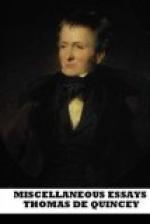The case of the M’Keands I consider far beyond the vaunted performance of Thurtell,—indeed above all praise; and bearing that relation, in fact, to the immortal works of Williams, which the AEneid bears to the Iliad.
But it is now time that I should say a few words about the principles of murder, not with a view to regulate your practice, but your judgment: as to old women, and the mob of newspaper readers, they are pleased with anything, provided it is bloody enough. But the mind of sensibility requires something more. First, then, let us speak of the kind of person who is adapted to the purpose of the murderer; secondly, of the place where; thirdly, of the time when, and other little circumstances.
As to the person, I suppose it is evident that he ought to be a good man; because, if he were not, he might himself, by possibility, be contemplating murder at the very time; and such “diamond-cut-diamond” tussles, though pleasant enough where nothing better is stirring, are really not what a critic can allow himself to call murders. I could mention some people (I name no names) who have been murdered by other people in a dark lane; and so far all seemed correct enough; but, on looking farther into the matter, the public have become aware that the murdered party was himself, at the moment, planning to rob his murderer, at the least, and possibly to murder him, if he had been strong enough. Whenever that is the case, or may be thought to be the case, farewell to all the genuine effects of the art. For the final purpose of murder, considered as a fine art, is precisely the same as that of tragedy, in Aristotle’s account of it, viz., “to cleanse the heart by means of pity and terror.” Now, terror there may be, but how can there be any pity for one tiger destroyed by another tiger?
It is also evident that the person selected ought not to be a public character. For instance, no judicious artist would have attempted to murder Abraham Newland. For the case was this; everybody read so much about Abraham Newland, and so few people ever saw him, that there was a fixed belief that he was an abstract idea. And I remember that once, when I happened to mention that I had dined at a coffee-house in company with Abraham Newland, everybody looked scornfully at me, as though I had pretended to have




